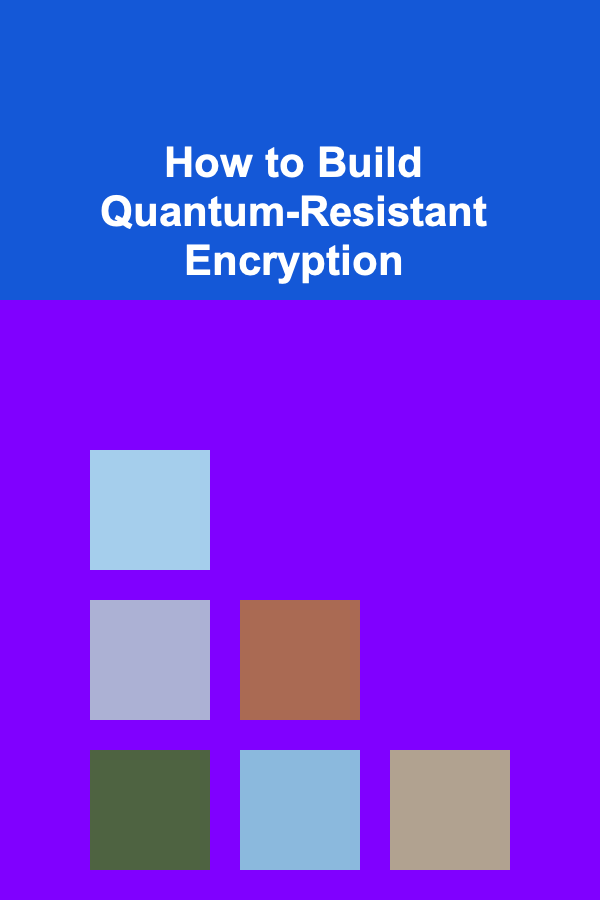
How to Build Quantum-Resistant Encryption
ebook include PDF & Audio bundle (Micro Guide)
$12.99$5.99
Limited Time Offer! Order within the next:

In the digital age, data security is of paramount importance. Traditional encryption techniques, such as RSA and ECC (Elliptic Curve Cryptography), are foundational to securing communications, transactions, and data storage. However, with the advent of quantum computing, many of these traditional encryption methods are becoming vulnerable to powerful quantum algorithms capable of breaking their security in ways that classical computers cannot. This poses a significant challenge for the future of data privacy and security.
In this article, we will explore how to build quantum-resistant encryption systems, also known as post-quantum cryptography. We will discuss the background of quantum computing, the potential threats it poses to current encryption techniques, and how researchers are developing new cryptographic methods to withstand quantum attacks.
The Rise of Quantum Computing
Quantum computing harnesses the principles of quantum mechanics to perform computations that are impossible or impractical for classical computers. Unlike classical bits, which can be either 0 or 1, quantum bits (qubits) can exist in a superposition of states. This enables quantum computers to perform many calculations in parallel and solve certain problems exponentially faster than classical computers.
One of the most famous quantum algorithms is Shor's algorithm, which can efficiently factor large numbers into primes. This is a critical operation in traditional public-key encryption systems like RSA. Using Shor's algorithm, a sufficiently powerful quantum computer could break RSA encryption by quickly factoring the large prime numbers that form the basis of its security.
Another significant quantum algorithm is Grover's algorithm, which provides a quadratic speedup for searching unsorted databases. Although Grover's algorithm does not break encryption methods directly, it could be used to reduce the security of symmetric encryption schemes, like AES, by halving their effective key length.
With the growing progress in quantum computing research, the need for encryption methods that are resistant to quantum attacks is becoming urgent.
Why Quantum-Resistant Encryption Is Essential
Quantum computers will not immediately replace classical computers. However, as quantum computing technology advances, it could eventually render many of the current encryption algorithms obsolete. The problem lies in the fact that many encryption techniques used today are based on mathematical problems that classical computers find difficult, but quantum computers can solve efficiently.
For instance, RSA encryption relies on the difficulty of factoring large numbers. While it may take millions of years for a classical computer to factor a large enough number to break an RSA key, a quantum computer using Shor's algorithm could potentially break that same encryption in just seconds.
Similarly, ECC relies on the difficulty of solving the elliptic curve discrete logarithm problem (ECDLP). This too can be broken efficiently by quantum algorithms. As quantum computers become more powerful, the need for quantum-resistant encryption methods becomes more critical. These methods must be capable of securing sensitive data even in a world where quantum computers are a reality.
Characteristics of Quantum-Resistant Encryption
Quantum-resistant encryption, also known as post-quantum cryptography, is a class of cryptographic algorithms designed to withstand attacks by quantum computers. To build such encryption methods, researchers focus on finding mathematical problems that are difficult for both classical and quantum computers to solve. There are several key characteristics of quantum-resistant encryption systems:
1. Hardness for Both Classical and Quantum Computers
The foundation of quantum-resistant encryption lies in selecting problems that are difficult for both quantum and classical computers. For example, while RSA and ECC rely on problems that are efficiently solvable by quantum computers, quantum-resistant encryption is based on problems that are not easily solvable by either.
2. Post-Quantum Security
The goal of post-quantum cryptography is to develop algorithms that will remain secure even when large-scale quantum computers become available. These systems must be evaluated rigorously to ensure they are resistant to both classical and quantum threats.
3. Key Size and Efficiency
One of the challenges of quantum-resistant encryption is balancing security and performance. Quantum-resistant algorithms often require larger key sizes than their classical counterparts, which can lead to increased computational overhead. Developers must design systems that offer strong security without significant performance degradation.
4. Public and Private Key Management
As with traditional encryption systems, quantum-resistant encryption must address both public and private key management. Secure key exchange, digital signatures, and encryption schemes need to be designed to ensure that users can safely communicate and verify identities without the risk of quantum attacks.
Approaches to Quantum-Resistant Encryption
Researchers are exploring several promising cryptographic approaches to create quantum-resistant encryption. These approaches are based on mathematical problems that are believed to be difficult for quantum computers to solve. Let's explore the most notable ones.
1. Lattice-Based Cryptography
Lattice-based cryptography is one of the most widely studied areas of post-quantum cryptography. It relies on problems involving lattice structures in high-dimensional spaces. The most famous example of a lattice-based problem is the Learning With Errors (LWE) problem, which is believed to be hard for both classical and quantum computers.
Lattice-based cryptographic schemes offer a wide range of cryptographic primitives, including public-key encryption, digital signatures, and key exchange protocols. These systems have the advantage of being efficient and resistant to quantum attacks, making them a promising foundation for quantum-resistant encryption.
Key Lattice-Based Algorithms:
- FrodoKEM: A key encapsulation mechanism based on the LWE problem.
- Kyber: A key exchange protocol based on lattice-based cryptography.
- NTRU: A public-key encryption system based on lattice problems.
2. Code-Based Cryptography
Code-based cryptography is based on error-correcting codes, which are mathematical methods used to detect and correct errors in data transmission. The most famous code-based encryption algorithm is McEliece, which is based on the difficulty of decoding random linear codes.
The McEliece cryptosystem has been extensively studied and is believed to be secure against quantum attacks. Its key size is relatively large compared to traditional systems, but it offers strong security guarantees and has been considered for adoption in post-quantum cryptography standards.
Key Code-Based Algorithms:
- McEliece: A public-key encryption system based on error-correcting codes.
- Niederreiter: A variant of McEliece based on the syndrome decoding problem.
3. Multivariate Quadratic Equations (MQ)
Multivariate quadratic equations involve solving systems of nonlinear equations over finite fields. The MQ problem is considered to be difficult for both classical and quantum computers, making it a promising foundation for post-quantum cryptography.
Multivariate-based cryptographic systems can be used for digital signatures and public-key encryption. However, they tend to have larger key sizes, which can limit their efficiency in some applications.
Key MQ-Based Algorithms:
- Rainbow: A digital signature scheme based on multivariate quadratic equations.
- GeMSS: A multivariate public-key encryption system.
4. Hash-Based Cryptography
Hash-based cryptography relies on hash functions to provide security guarantees. The most widely known hash-based signature scheme is XMSS (eXtended Merkle Signature Scheme), which uses a hash tree structure to provide secure digital signatures.
Hash-based schemes are considered to be quantum-resistant because hash functions are believed to be resistant to quantum attacks, although Grover's algorithm could potentially speed up the process of finding collisions. Nevertheless, hash-based cryptography remains one of the most practical post-quantum cryptographic techniques.
Key Hash-Based Algorithms:
- XMSS: A stateful hash-based signature scheme.
- SPHINCS+: A stateless hash-based signature scheme.
5. Isogeny-Based Cryptography
Isogeny-based cryptography relies on the mathematical concept of isogenies, which are functions between elliptic curves. Isogeny-based encryption schemes are believed to be resistant to quantum attacks and offer promising potential for key exchange protocols.
Although isogeny-based cryptography is still in its early stages compared to other approaches like lattice-based cryptography, it shows promise as a post-quantum cryptographic primitive.
Key Isogeny-Based Algorithms:
- SIDH: A key exchange protocol based on isogenies between elliptic curves.
- SIKE: A public-key encryption system based on supersingular isogenies.
Implementing Quantum-Resistant Encryption
Building a quantum-resistant encryption system involves more than just selecting the right cryptographic algorithms. It also requires careful implementation and consideration of various system design factors. Here are the key steps involved in implementing a quantum-resistant encryption system:
1. Choosing the Right Algorithms
Depending on the application, you must select the appropriate quantum-resistant cryptographic algorithms. For example, lattice-based algorithms like Kyber may be suitable for key exchange, while hash-based schemes like XMSS could be ideal for digital signatures.
2. Key Size and Performance Optimization
Quantum-resistant algorithms often require larger key sizes than their classical counterparts. However, larger keys can lead to performance issues. Optimization strategies, such as parallelization and hardware acceleration, can help mitigate performance bottlenecks.
3. Hybrid Encryption
In the transition to quantum-resistant systems, many organizations are adopting hybrid encryption schemes. These systems combine classical and quantum-resistant algorithms to provide security both now and in the future. For example, a hybrid encryption system might use RSA or ECC for current operations and a quantum-resistant algorithm like Kyber for future-proofing.
4. Standardization and Interoperability
The National Institute of Standards and Technology (NIST) is currently working on standardizing post-quantum cryptography. Once these standards are in place, organizations will be able to implement quantum-resistant encryption systems with confidence that they adhere to global security standards. It's essential to ensure that your encryption system is compatible with existing protocols and systems.
Conclusion
As quantum computing continues to evolve, traditional encryption methods are becoming increasingly vulnerable. Quantum-resistant encryption is crucial for securing sensitive data against the threats posed by future quantum computers. Lattice-based cryptography, code-based cryptography, hash-based cryptography, and isogeny-based cryptography represent some of the most promising approaches to building post-quantum encryption systems.
The development of quantum-resistant encryption is a complex and ongoing process that requires careful algorithm selection, performance optimization, and adherence to emerging standards. By adopting quantum-resistant algorithms and preparing for the quantum future, we can ensure that data remains secure in the age of quantum computing.

How To Develop a Strong Personal Brand for Job Search
Read More
Understanding Orbital Mechanics: A Deep Dive
Read More
Creating a Pet-Friendly Interior: A Comprehensive Guide
Read More
How to Plan a Bike Trip with Pets
Read More
10 Tips for Guitarists: Structuring Your Practice with a Planner
Read More
10 Tips for Animating 3D Environments in Unreal Engine
Read MoreOther Products

How To Develop a Strong Personal Brand for Job Search
Read More
Understanding Orbital Mechanics: A Deep Dive
Read More
Creating a Pet-Friendly Interior: A Comprehensive Guide
Read More
How to Plan a Bike Trip with Pets
Read More
10 Tips for Guitarists: Structuring Your Practice with a Planner
Read More